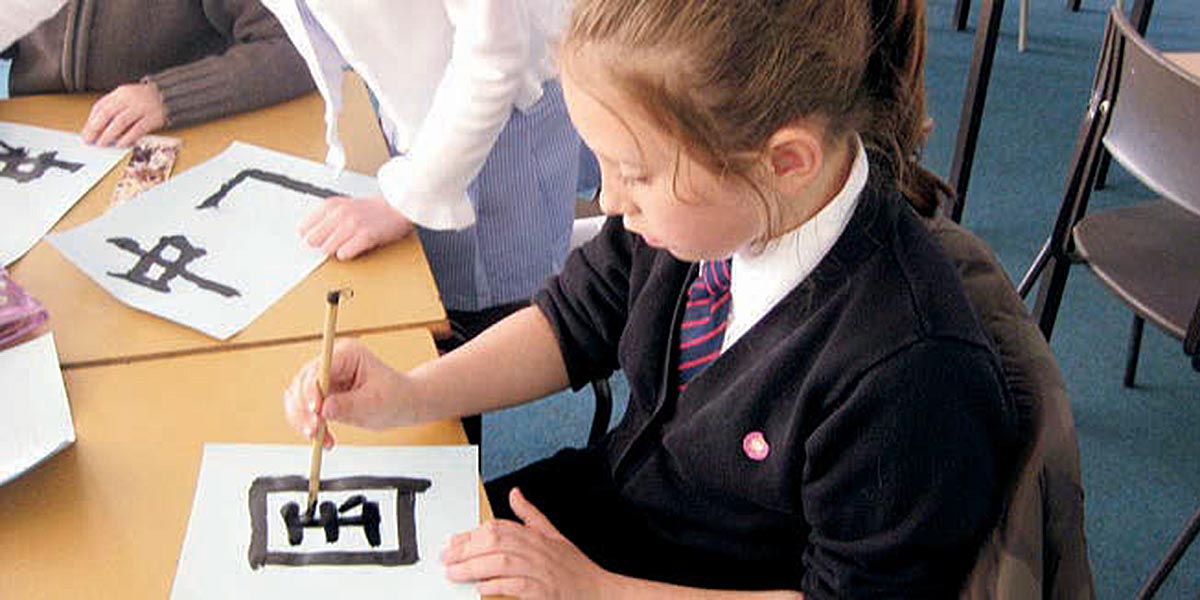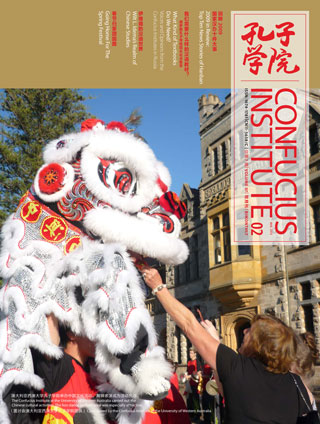

With careful strokes, the students practice writing Chinese characters.
Shang Fei: “Chinese calligraphy welcomed among british students”
Shang Fei: “Amazed by Chinese characters written with the brush, with lines of uneven thickness and melodically rhythmic strokes where the aroma of the ink lingered, the students repeatedly asked me to write more on spot”.
Currently there are over 4,000 Chinese language teachers and volunteers teaching Chinese in Confucius Institutes, primary and secondary schools and universities throughout the world. While spreading Chinese language and culture, these cultural envoys personally experienced exchanges and interactions with different teaching practices and other cultures. The column of Teachers’ Voices is a channel where Chinese language teachers and volunteers can share their teaching experience with each other. There will also be a collection of stories on their unique experiences in foreign lands these cultural envoys can share with our readers.
Shang Fei, Teacher of Chinese at the Confucius Institute at Specialist Schools and Academies Trust, U.K.
Between September 2008 and July 2009, I taught Chinese language and culture at the Confucius Institute at Specialist Schools and Academies Trust in the U.K. as a government-sponsored Hanban Chinese teacher. I understood very well that my responsibility as a Chinese teacher who had crossed the oceans to teach in a foreign country was not limited to language instruction, that I was also supposed to be a propagator of culture helping foreigners learn about China.
When teaching Chinese, I found that, because the sounds and the forms in Chinese are independent of each other, writing Chinese is a difficult task for British students. During one class, I played a little game with the students. I divided each Chinese character into its different components, writing each out separately, with a brush, on different cards. The cards were then shuffled so that they were not in any particular order. Then I asked the students to form correct Chinese characters according to my instructions. The British students loved this game. Amazed by Chinese characters written with the brush, with lines of uneven thickness and melodically rhythmic strokes where the aroma of the ink lingered, the students repeatedly asked me to write more on spot. Seeing the students so eager to learn, I had an inspiration: why not combine chinese calligraphy with the teaching of Chinese characters? First, I taught them the correct way to hold the brush and simple versions of horizontal and vertical strokes. Then, every time we reviewed vocabularies, I used slides to show the students, divided into groups, Chinese characters in rapid succession, each slide view lasting only 10 seconds. The students, using a brush to write Chinese characters on water writing paper, competed to see which group would be fastest. I had never expected that calligraphy could add so much excitement to teaching Chinese characters. To this day, images of the students vying to hold their Chinese characters as high as possible in front of me comes back to me again and again.

In order for the children to feel the joy of learning, in my culture class, I taught them some painting information to learn to appreciate calligraphy and see the beauty of having calligraphy and painting in one. I showed the students flash images with elements of Chinese calligraphy and painting. At the sound of the elegantly melodic classical Chinese music, in front of the splendid beauty of Chinese watercolor paintings, and at the sight of calligraphic renditions of Chinese characters that were ethereal or free or rugged or gracefully restrained, these British children invariably found themselves in awe of traditional Chinese culture. The students also displayed a keen interest in the “Four Treasures of the Study” when I showed these to them. They were stunned to see the carved patterns and images on the little ink stone so full of auspicious symbolism, to witness the thin rice paper so capably receive strokes of inked brushes, and to know that the ink stone and mere water can work together to produce shining black ink.
The students were so delighted with the brush that they could hardly bear to put it down. It then occurred to me that they could paint the giant panda using the brush. The students surprised me with paintings that invariably depicted a panda that was clumsily and innocently cute. On each painting was also written the two characters for the word “panda” – with strokes that were exuberantly lively despite the childish looks. Some students even signed their name beside the panda they had painted, proudly declaring: “I can do Chinese painting! I can write Chinese characters!”
Only an amateur of calligraphy myself, I was well aware that I could only offer these children a rudimentary initiation. My hope, however, was that my work would open a door to people interested in learning about China, helping them appreciate the splendor of five thousand years of culture from a different perspective and know the real China. That would make this overseas trip even more worthwhile.























No hay comentarios:
Publicar un comentario